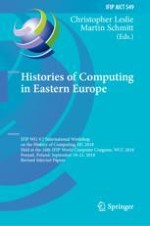2019 | Buch
Histories of Computing in Eastern Europe
IFIP WG 9.7 International Workshop on the History of Computing, HC 2018, Held at the 24th IFIP World Computer Congress, WCC 2018, Poznań, Poland, September 19–21, 2018, Revised Selected Papers
herausgegeben von: Christopher Leslie, Martin Schmitt
Verlag: Springer International Publishing
Buchreihe : IFIP Advances in Information and Communication Technology
